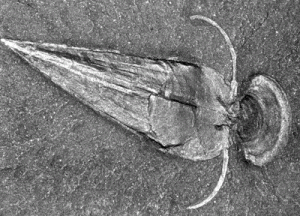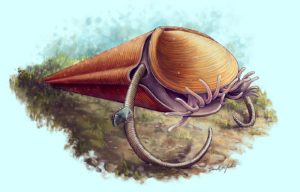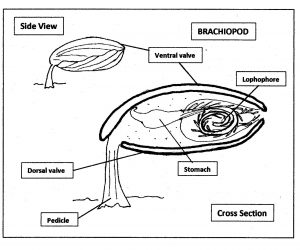Just this week an article has been published in the scientific journal Nature that clears up a problem that has plagued paleontologists for over 175 years. The paper by Joseph Moysiuk and Jean Bernard Caron of the University of Toronto along with Martin R. Smith of Cambridge University examined over 1500 specimens of Hyoliths, a rather common Paleozoic marine fossil whose shell resembles an ice cream cone with a lid on top and a spine coming out each side, see picture below.

Because only the hard parts of extinct animals are usually preserved the exact kind of animal that lived inside the Hyolith shell remained a mystery. The most common guess was that Hyoliths were a mollusk, that they were either a snail or clam of some kind. However, using specimens from the famous Burgess Shale formation in British Columbia Professor Moysiuk et al succeeded in finding enough of the soft tissue of Hyoliths to be able to determine their feeding mechanism and it turns out that Hyoliths are not mollusks at all but instead are related to Brachiopods, a ancient and very common type of fossil but a phylum which today contains only a few rare species. See the picture below for a reconstruction of a Hyolith.

Compare this to a modern Brachiopod.

Whereas Brachiopods attach themselves to the sea bottom by means of a fleshy “pedicle” the Hyoliths seem to have pushed their conic shell into the sand and raised themselves up on their two spines. Because of this difference the scientists maintain that Hyoliths are related to the Brachiopods within a larger group called Lophophorates instead of being a Brachiopod.
The small tentacles reaching out of the Hyolith is the lophophore, the feeding structure common between the Hyoliths and Brachiopods and which gives the larger group its name. If you’d like to read an article in Sci-News about the work of Professor Moysiuk et al click on the link below.
http://www.sci-news.com/paleontology/hyoliths-cambrian-lophophorates-04531.html
I have two specimens of Hyoliths in my fossil collection, along with thousands of Brachiopods so this discovery by Professor Moysiuk et al is of particular interest to me. Like Dinosaurs and Trilobites I think that the more we learn about the animals that once lived on this Earth the more fascinating they become.
Maybe one day I’ll get to do a post on Nidulites, a rarer and more mysterious Paleozoic marine fossil of which I have about a dozen specimens. Till then.

I am sure this article has touched all the internet viewers, its really really pleasant
post on building up new blog.
I would like to thank you for the efforts you have put in writing this site.
I really hope to check out the same high-grade blog posts by you in the future as well.
In fact, your creative writing abilities has inspired me to get
my very own site now
Thanks for the comment. Starting a blog takes a bit of work at first but you can the hang of it pretty fast and it can be a lot of fun. Good Lock!
Bob L
Hi, this weekend is fastidious for me, for the reason that this
point in time i am reading this fantastic informative paragraph here at my house.
Thanks for the comment, I’ll try to keep up the quality!
Bob L
Definitely believe that which you stated.
Your favorite justification appeared to be at the net the simplest factor to understand of.
I say to you, I definitely get irked at the same time as people think about worries that they plainly don’t realize
about. You managed to hit the nail upon the highest as
well as defined out the whole thing without having side effect , folks can take a signal.
Will likely be back to get more. Thanks
Greate pieces. Keep posting such kind of information on your page.
Im really impressed by your blog.
Hi there, You have performed an incredible job. I’ll certainly digg it and for my part recommend to my friends.
I am confident they will be benefited from this website.
Thanks for the comment and do tell all your friends!
Bob L
Jetzt Versicherung Drohne kaufen. Die preiswerteste Versicherung Drohne von den Koelner Maklern Beckersjürgen und Khalidi.
Pretty great post. I simply stumbled upon your blog
and wanted to say that I have really loved browsing your blog posts.
In any case I will be subscribing in your rss feed and I hope you write again soon!
Thanks for the comment. I try to post something new twice a week so I hope you’ll keep coming back.
Bob L
If some one desires to be updated with most
up-to-date technologies then he must be pay a quick visit this site and be up to date daily.
And I hope you’ll be coming back daily. Thanks for the comment.
Bob L
Nice blog here! Also your site loads up fast! What
host are you using? Can I get your affiliate link to your host?
I wish my web site loaded up as quickly as yours lol
Thanks for the comment. My site is hosted by Ipage (www.ipage.com) and the program is wordpress. Hope that helps.
Bob L
I like what you guys are up too. This type of clever
work and coverage! Keep up the very good works guys I’ve added you guys to blogroll.
Well thanks for the comment but I would point out that ‘you guys’ is just me! Thanks again.
Bob L
I go to see day-to-day some web sites and sites to read content, except this weblog gives feature
based content.
Thanks for the comment and I hope you’ll keep coming back!
Bob L
Really impressed for the new comers. Keep going.
I’ll keep going if you keep coming back. Deal? Thanks for the comment!
Bob L
My coder is trying to convince me to move to .net from PHP.
I have always disliked the idea because of the costs. But he’s tryiong none the less.
I’ve been using WordPress on several websites for about a
year and am worried about switching to another platform. I have heard great
things about blogengine.net. Is there a way I can transfer all my wordpress content into it?
Any help would be greatly appreciated!
Thanks for the comment. You’re really asking the wrong person when it comes to the difference between .net or .PHP or whatever. I use wordpress and my site is hosted by Ipage and I let them take care of that stuff! Sorry!
Bob L
I don’t even know how I ended up here, but I thought this post Cheers!
Cheers!
was good. I do not know who you are but certainly you are going to a famous blogger if you are not
already
Thanks for the comment. You can help make me famous by telling all your friends.
Bob L
Heya i am for the first time here. I came across this board
and I find It truly helpful & it helped me out a lot.
I hope to provide one thing again and aid others like you aided me.
Thanks for the comment. You can help others by telling all of your friends!
Bob L
It’s very trouble-free to find out any topic on web as compared to
books, as I found this piece of writing at this web
site.
Thanks for the comment and hope you come back soon!
Bob L
Hello There. I found your blog using msn. This is
a very well written article. I’ll be sure to bookmark it and come back to
read more of your useful info. Thanks for the post. I will definitely return.
Thanks for the comment and come back soon!
Bob L
Heya i am for the first time here. I came across
this board and I find It truly helpful & it helped
me out a lot. I hope to present something again and help others such
as you helped me.
It’s going to be ending of mine day, however before end
I am reading this impressive paragraph to increase my knowledge.
Thanks for the comment and I hope that you’ll check out my other posts!
Bob L
Thanks for finally writing about >After 175 Years
of Mystery, Hyoliths have finally been Classified – Scienceandsf <Liked it!
Thank you for the comment and I hope that you’ll check out some more of my posts!
Bob L
Hello, just wanted to say, I loved this blog
post. It was practical. Keep on posting!
I feel this is among the such a lot important info for me.
And i am glad reading your article. But want to statement on some common issues, The web site taste is ideal,
the articles is truly great : D. Excellent activity, cheers
Whoa! This blog looks exactly like my old one!
It’s on a completely different topic but it has pretty much
the same page layout and design. Wonderful choice of colors!
Thanks for the comment and come back soon!
Bob L
Thanks for the comment and come back soon!
Bob L